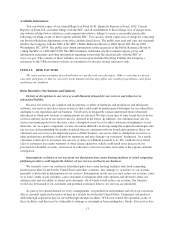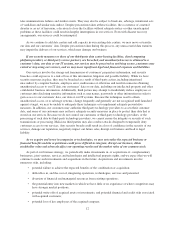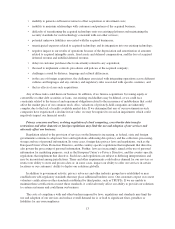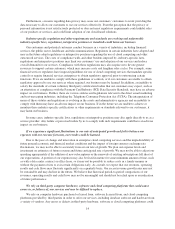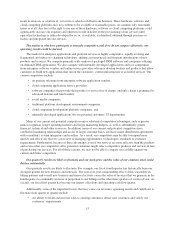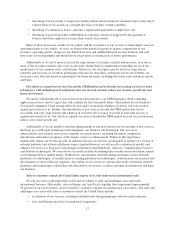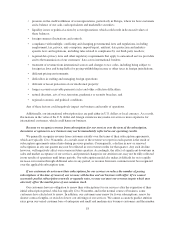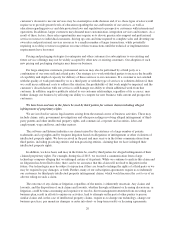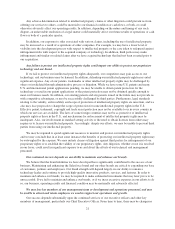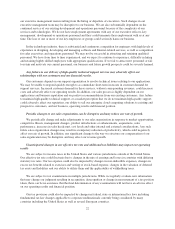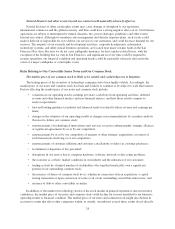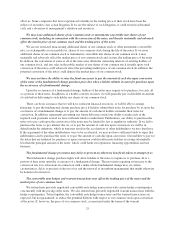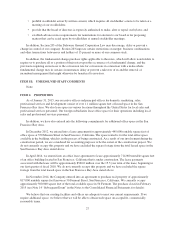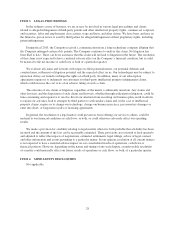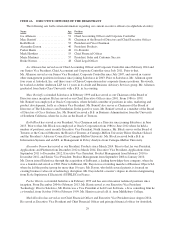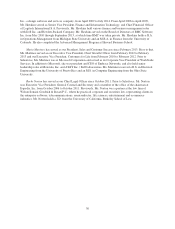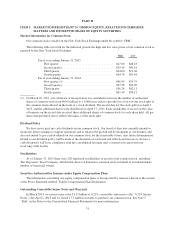Salesforce.com 2015 Annual Report Download - page 27
Download and view the complete annual report
Please find page 27 of the 2015 Salesforce.com annual report below. You can navigate through the pages in the report by either clicking on the pages listed below, or by using the keyword search tool below to find specific information within the annual report.Any adverse determination related to intellectual property claims or other litigation could prevent us from
offering our services to others, could be material to our financial condition or cash flows, or both, or could
otherwise adversely affect our operating results. In addition, depending on the nature and timing of any such
dispute, an unfavorable resolution of a legal matter could materially affect our future results of operations or cash
flows or both of a particular quarter.
In addition, our exposure to risks associated with various claims, including the use of intellectual property,
may be increased as a result of acquisitions of other companies. For example, we may have a lower level of
visibility into the development process with respect to intellectual property or the care taken to safeguard against
infringement risks with respect to the acquired company or technology. In addition, third parties may make
infringement and similar or related claims after we have acquired technology that had not been asserted prior to
our acquisition.
Any failure to protect our intellectual property rights could impair our ability to protect our proprietary
technology and our brand.
If we fail to protect our intellectual property rights adequately, our competitors may gain access to our
technology, and our business may be harmed. In addition, defending our intellectual property rights may entail
significant expense. Any of our patents, trademarks or other intellectual property rights may be challenged by
others or invalidated through administrative process or litigation. While we have some U.S. patents and many
U.S. and international patent applications pending, we may be unable to obtain patent protection for the
technology covered in our patent applications or the patent protection may not be obtained quickly enough to
meet our business needs. In addition, our existing patents and any patents issued in the future may not provide us
with competitive advantages, or may be successfully challenged by third parties. Furthermore, legal standards
relating to the validity, enforceability and scope of protection of intellectual property rights are uncertain, and we
also may face proposals to change the scope of protection for some intellectual property rights in the U.S.
Effective patent, trademark, copyright and trade secret protection may not be available to us in every country in
which our services are available. The laws of some foreign countries may not be as protective of intellectual
property rights as those in the U.S., and mechanisms for enforcement of intellectual property rights may be
inadequate. Also, our involvement in standard setting activity or the need to obtain licenses from others may
require us to license our intellectual property. Accordingly, despite our efforts, we may be unable to prevent third
parties from using our intellectual property.
We may be required to spend significant resources to monitor and protect our intellectual property rights
and we may conclude that in at least some instances the benefits of protecting our intellectual property rights may
be outweighed by the expense. We may initiate claims or litigation against third parties for infringement of our
proprietary rights or to establish the validity of our proprietary rights. Any litigation, whether or not it is resolved
in our favor, could result in significant expense to us and divert the efforts of our technical and management
personnel.
Our continued success depends on our ability to maintain and enhance our brands.
We believe that the brand identities we have developed have significantly contributed to the success of our
business. Maintaining and enhancing the Salesforce brand and our other brands are critical to expanding our base
of customers, partners and employees. Our brand strength will depend largely on our ability to remain a
technology leader and continue to provide high-quality innovative products, services, and features. In order to
maintain and enhance our brands, we may be required to make substantial investments that may later prove to be
unsuccessful. If we fail to maintain and enhance our brands, or if we incur excessive expenses in our efforts to do
so, our business, operating results and financial condition may be materially and adversely affected.
We may lose key members of our management team or development and operations personnel, and may
be unable to attract and retain employees we need to support our operations and growth.
Our success depends substantially upon the continued services of our executive officers and other key
members of management, particularly our Chief Executive Officer. From time to time, there may be changes in
21


